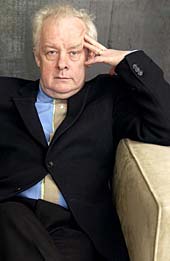 "A bit of a gambler" "A bit of a gambler" |
April 21, 2004 | Jim Sheridan has only directed five feature films since
1989, but each one is a fully realized story brimming with energy, rage and honesty.
Whether it's the gripping drama of My Left Foot and The Field or the
intense character studies in In The Name of The Father and The Boxer,
Sheridan's films have a richness and texture that really set them apart. His approach
is to make each story as personal as possible, to make his characters, with all their
faults and contradictions, totally real.
His latest film, In America is by far his most personal yet. In America
tells the story of a young Irish couple (played by the terrific Paddy Considine and
Samantha Morton, who was nominated for an Oscar) who, along with their daughters
(played by amazing real-life sisters Sarah and Emma Bolger), move to New York City with
nothing more than
the clothes on their backs. This tender film is unusual today for its level of
sincerity and open emotion, assets that seems lacking from a lot of recent
cinema.
A good deal of the film's central emotional pull comes from a character only glimpsed
through the viewfinder of the older daughter's ever-present camcorder: A young son
whose death inspired the journey. While the film's main scenario is taken directly from
Sheridan's life (he and his family moved to the city in the early 80's), the death of
the son is actually a reference to Sheridan's brother, who died as a child when the
director was 17 years old. A profound sense of longing and pain runs through the film and
makes the family's struggle with their new home all the more urgent.
As personal as the material is, Sheridan's approach matched it. He asked his daughters
Naomi and Kirsten to write their own scripts on the family's time in New York and then
combined them with his own ideas to create a shooting script with a lot of different
perspectives.
By mixing these autobiographical elements, Sheridan paints a picture of his
family's life
that is as impressionistic as it is straight-forward. From the kaleidoscopic opening
that finds the Sullivans driving through Times Square like it's a neon asteroid field,
to the moonlit E.T.-referencing ending, In America is the rare film that
finds a balance between fantasy and reality that completely works.
Cinema Gotham recently had the chance to ask Sheridan a few questions about the
film and his experiences making it.
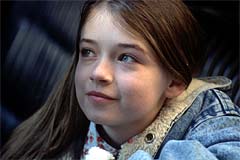 Sarah Bolger Sarah Bolger |
Cinema Gotham: I thought it was wonderful how when the film and the characters
first enter New York they go through this colorful, musical transition. How did
you come to that experience for them?
Jim Sheridan: Well, I think everybody who went to New York is overwhelmed a
little
bit by the city. Times Square was the only place lit enough that I could go do, you
know what I mean, without spending 10 million dollars. I knew it was a bit like "Oh,
everybody's seen Times Square," but I knew I had two special kids so I just used them.
We filmed Times Square and projected it in the studio. And then we shot the kids
and I could control all the laughter and reactions and whatever. Then we did
some exterior shots. I think we got a magical little scene, you know?
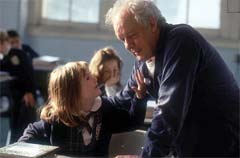 Action! Action!
Emma Bolger and Sheridan |
CG: It really works beautifully. And the Bolger sisters seem totally fearless in
their performances.
JS: Oh, they were amazing.
CG: On the DVD you mention that you let them call "action" and "cut" on the set.
It sounds like you had a pretty unique partnership with them.
JS: We had a great time [working] together. And that was a good thing to do.
They were fantastic. Their
performances are breathtaking. Samantha's eyes are amazing. She's a great actress and
Djimon has a huge soul. You just feed all that. And Paddy's like an everyman figure, so
all the cast really worked out well.
CG: You've mentioned that you don't micromanage your actors' performances. That
you trust them to interpret your writing in their own ways. Casting must be a big part
of finding the right people for that.
JS: Yeah, absolutely. Casting is 90% of filmmaking.
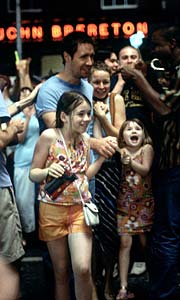 Considine, Morton and the Bolgers Considine, Morton and the Bolgers |
CG: And also, something I thought was really interesting was that the New York of
the film is sort of timeless. I mean, it has different elements from recent eras mixed
together. But certain details definitely come from the early 80's New York you
experienced.
JS: Well, New York has become a lot more yuppie since then, hasn't it? Much more
clean
and so on. But I couldn't afford to do a period movie. I just couldn't have all the
cars changed... I didn't have that kind of money or control, you know, so I
deliberately blurred the time period by [using] the video camera. I used the video to
kind of make it modern and I left some of the 80's issues.
CG: The drug elements...
JS: And AIDS, especially. And E.T. I was lucky enough they re-released
it.
CG: You shot in New York pretty soon after 9/11. What kind of effect
did that have on the production?
JS: The weird thing was that 9/11 happened while we were shooting
the last week in Dublin. We found it very difficult because we were supposed to go to
New York and we had to delay a
little bit. But we were the first film in there after 9/11 so everybody was really warm
to
us. But it was actually very hard not to [think about] 9/11 because the film is about
grief and I knew
it would have that kind of impact being in the city. But everyone was really good to us
and treated us great. It was a warm feeling.
CG: Another recent film, Gangs of New York, told the story of earlier waves
of Irish immigrants. How do you think that experience has changed over time?
JS: One of the confusions the English had about my film was they were
wondering why the main
characters didn't go to their relations, you know? The people they knew. And the truth
about
Irish immigration, also Italians and to an extent Jewish, was that the early immigrants
were all peasants from the land. And they were running off the land, whether they were
blacks going to Chicago and Irish and Italians going to the east coast. They
didn't want to be indentured slaves on the land anymore. And the Irish were escaping
the
famine so they were coming from a desperate situation. Then there was a break in
immigration after the 50's in Ireland when America wasn't allowing so many in.
Therefore, in
the 80's illegal immigration started for the Irish. And that was city people, like me.
I come from Dublin and Dubliners had no relations in America. So it's a different
experience, a different
type of people who are used to cities whereas the first immigrants weren't used to
cities at
all. It was like complete chaos to them.
CG: Your film is autobiographical, but it seems like it takes two
distinct times from your life and combines them. That's pretty unusual.
JS: That is kind of odd. It does. It takes two periods and squashes them
together. And [the film] takes
me and my father and puts them in one character. So, it was a unique kind of way to
do it. In a funny way I realize that dramatic characters are built of many people and
that's
what gives them their interest, their edge. We tend to think
cohesively of one person as a character. I think dramatic characters are often
composites of seven, eight, nine people and
that gives them edge and life and contradiction whereas most people in reality tend to
get
a bit boring because they're the same all the time. We get stuck on paths that we think
we
can't get off. So when I made myself a bit like my father that gave me a huge ability
to
see the character from two or three perspectives whereas up to that point he tended to
be one dimensional.
CG: That character is a bit of a gambler. I mean, he does gamble in a way in the
film, but it's also very risky moving his family to this unknown place and also his
wanting to be an actor is a big gamble.
JS: The funny thing is I'm a bit of a gambler myself but my dad was really a
gambler and the
attitude of the little girl in the film to the tension is what I used to feel when I
was a
kid when my dad gambled, so it's kind of a composite. I suppose you can
say my wife is more of a gambler. [Laughs] She's here looking at me, giving me the evil
eye.
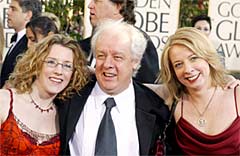 The Writing Sheridans: Kirsten, Jim and Naomi The Writing Sheridans: Kirsten, Jim and Naomi
at the Golden
Globes |
CG: What does she think of you making a film that lays your life together
out so openly?
JS: Well, I think she likes it. She says her character got nominated and mine
didn't. She said
that was just because she was more interesting! [Laughs]
CG: And you wrote the script with your daughters. How did that work?
JS: Oh, they loved it. It was a good experience. We all got to know new
things about each
other and it was a pleasant experience. There weren't too many fights. A few
disagreements. We all came
out without too many bruises. And they were delighted to go to the Oscars.
CG: You've written some fine scripts before on your own. What perspective did
they add to the process for you?
JS: They gave me the children's point of view a lot. Kirsten wrote hers as a
six year old and
Naomi wrote hers as a ten year old. And the six year old was the hero in Kirsten's and the
ten year
old was the hero in Naomi's. I learned a lot so when I came to the film I was able
to
get the kids' perspective just by having their scripts in my head as well.
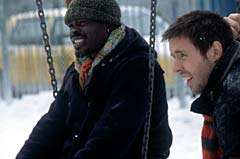 Honsou and Considine Honsou and Considine |
CG: You mention on the DVD that home video is the new memory. How do you feel
technology is affecting people's
traditions?
JS: It's just making them very much more visual, you know? It's a new world.
Everybody
can be an actor, everybody can be a star in their own film. It's quite mad. Quite
insane,
actually.
CG: What about trends in technology like DVDs that bring so much of the
filmmaker's process into the open? Some people don't like that so much.
JS: Some people don't?
CG: Well, Woody Allen refuses to do commentaries for his movies.
JS: [Laughs] Well, he might just be trying to avoid two hours of nonstop
talking.
In America is now available for pre-order. It features an
excellent director's commentary, so you can hear Sheridan talk nonstop for two hours for
yourself.
Also, read Keith
Uhlich's essay about In America in Cinema Gotham. and Gil Jawetz's DVD review of In America

